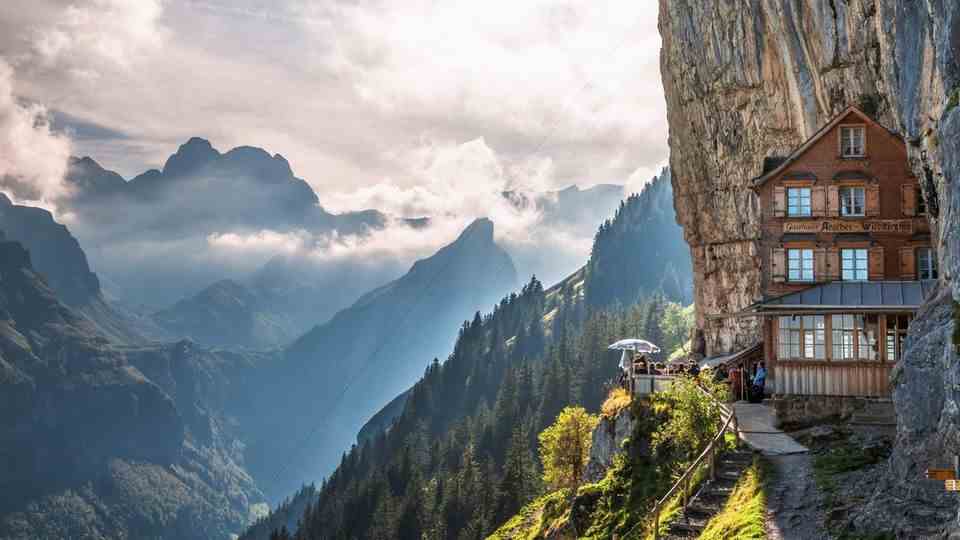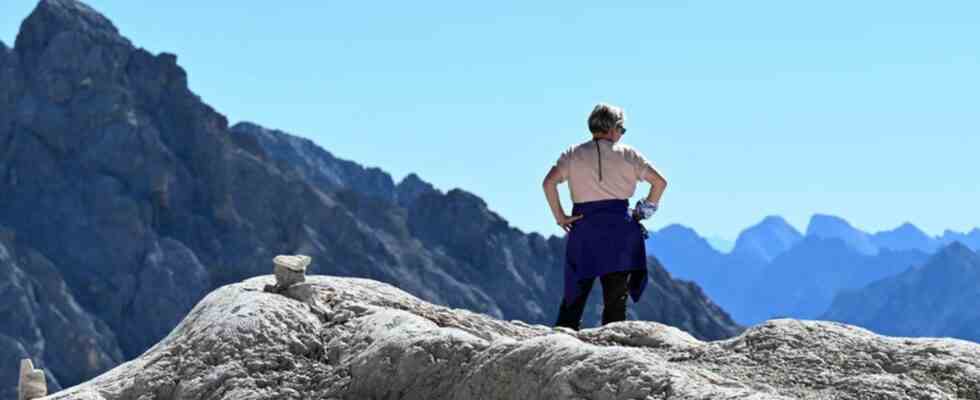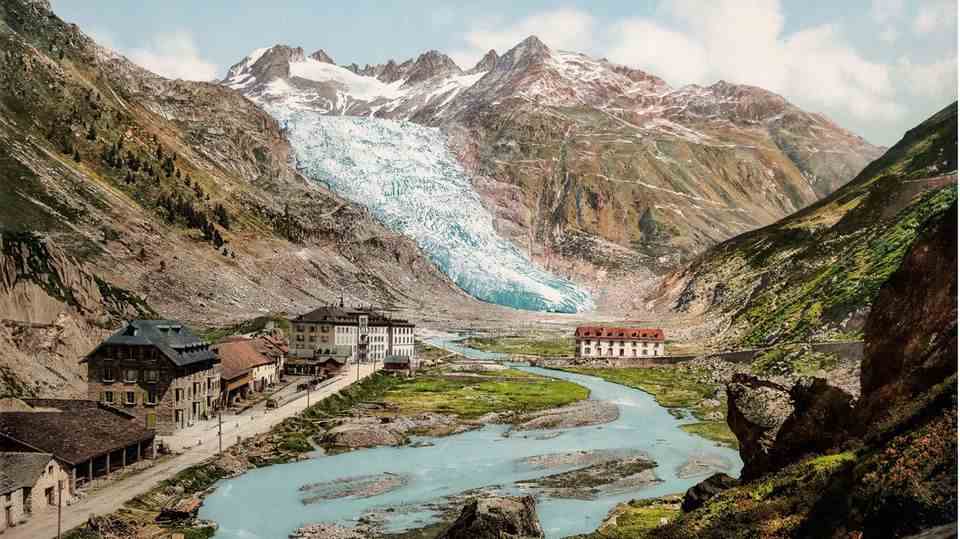The warm, dry weather this summer is drawing many people to the mountains. When hiking, there are a number of things to consider – from equipment to provisions to self-assessment. Good preparation helps to avoid dangers and accidents. Here are tips from professionals.
These are sad records. The Swiss Air-Rescue (Rega) has never had as many missions as this July. There were a total of 2,120. “Ten years ago, a so-called 1,000 month was remarkable for us,” said Rega boss Ernst Kohler to the “Tages-Anzeiger”. By now they would regularly count five to six such months.
Safety in the mountains, guilt, masses of tourists and the right equipment are currently being discussed, especially in the Alpstein. In the popular mountain region in eastern Switzerland, five people fell to their deaths within five weeks this summer.

The mountain inn Aescher with its spectacular location in the Alpstein is a tourist magnet
Sad record in the Bavarian mountains
The number of accidents is also increasing in Bavaria’s mountains. There, the police headquarters in Upper Bavaria South, which stretches from Berchtesgaden to Garmisch-Partenkirchen, registered a total of 55 mountain deaths in 2021 – more than ever since systematic recording began in 2009. The triggers for this are mostly banal – a simple slip, a short stumble – the reasons behind it varied, as the “Süddeutsche Zeitung” writes.
Roland Ampenberger, press spokesman for the Bavarian Mountain Rescue Service, speaks up star– Enquiry: “Since the beginning of this year we have recorded 51 calls in accidents and emergencies with a fatal outcome. This includes hiking and winter sports.” The Bergwacht Bayern is responsible for all Bavarian low mountain ranges and mountains. And she has known a clear trend for ten years: more assignments. While there were still 2836 in the summer of 2017, the mountain rescue service already recorded 3650 in 2021. This summer, with 1200 missions from May 1st to mid-July, is on average in recent years, according to Ampenberger.
But the spokesman also says: “Fortunately, the number is not growing proportionally with the people who are drawn to the mountains. Because there are many more people hiking today than 20 years ago.” It sounds similar with Rega boss Kohler in Switzerland: “On a beautiful summer’s day, around 80,000 people use the mountain railways in Switzerland. If we are on duty for hikers a dozen times during this time, very little happens in comparison.” People are drawn to the mountains, Corona has given hiking a further boost. Out of the city, up the mountain.
This can be one of the problems: “What hikers should never forget: the mountains are not the city. Luckily you can move around there more freely than in many other places, you are out in nature, but that doesn’t mean that either everything is as regulated as in the city,” says Ampenberger.
One reason for rescue operations is being overwhelmed
According to the mountain rescue service, there is no one main cause of accidents. But it is clear: “When people are active, something is more likely to happen.” In many cases, this has nothing to do with the mountain, such as classic “sports accidents” or internal problems that could also have arisen in the valley. Because they happen on the mountain, medical care and rescue is more difficult.
“A frequent cause of accidents in the mountains are falls,” says Ampenberger. The reason for this – whether someone was inattentive, overwhelmed or distracted or whether it was the shoe, one cannot say conclusively. “Because we weren’t there.” One reason is overload. “In autumn people often underestimate how early it gets dark, in spring old snowfields are always a problem. A change in the weather can also lead to operations or when a path is suddenly too steep or too narrow and people don’t dare to go forwards or backwards .”
Plan carefully, leave early – tips for hiking
For a low-risk, successful hike, there are a number of things to consider. Julia Janotte from safety research at the German Alpine Club (DAV) says:
The be-all and end-all of a hike is thorough planning. Inform yourself, plan defensively.
You should look at the route beforehand and take a map with you and not just rely on apps. The local DAV sections could also help. Your other tips:
- Set off earlier, especially in summer, so that you can take a break in the shade in the midday heat and not start first.
- Take regular breaks.
- You should know your own limits and in a group go for the weakest link.
- Beginners should start with easier, shorter routes and work their way up. Don’t want to go straight to the Zugspitze or the Watzmann.
- Take provisions with you, especially drinks now in summer.
- Wear sun protection and a hat, because UV radiation is higher in the mountains.
- Good shoes are of course a basic requirement.
Roland Ampenberger from the mountain rescue service has very similar tips. His most important: “Be on the move with reserves and rather defensively, especially when you approach the topic of mountains for the first time. Reserves in terms of your own physical performance, clothing, eating and especially drinking.” As soon as technical equipment is required, such as on a via ferrata, training is essential.
Equipment and experience should match the project. And this can be very individual. Too much equipment, too heavy a backpack with a lot of “luxury equipment” becomes a burden on a demanding tour.
Climate change and hiking
The highest mountain in the Alps is making headlines this summer. Lack of snow and increasingly warm temperatures lead to very difficult conditions for tours to Mont Blanc. The danger of crevasses and falling rocks on the main route is currently extremely high, reported the “Tagesschau” in early August. Despite explicit warnings, amateur alpinists still chose this route. The authorities have therefore closed mountain huts. The possible routes are reserved for experts because of their level of difficulty.

Climbing Mont Blanc: the Goûter hut is at 3835 meters
© Jean-Pierre Clatot / AFP
Climate change has long since arrived in the Alps. In the “Tages-Anzeiger” Rega boss Ernst Kohler spoke about the changed mountain world in Switzerland with melting permafrost, which is causing the rocks to crumble. The changed temperatures would also affect the hiking trails. The rock becomes loose, which also increases the risk of falling rocks at lower altitudes.
Julia Janotte from the German Alpine Association says: “We are not yet feeling the effects of climate change as strongly as in the high Alpine region. But the Alps in Bavaria will also change over the long term. For example, due to heavy rain slopes can slip.” Caution when hiking will also be required in the future – for various reasons.
Sources: Tages-Anzeiger, Southgerman newspaper, St. Galler Tagblatt, German Alpine Club, daily News


